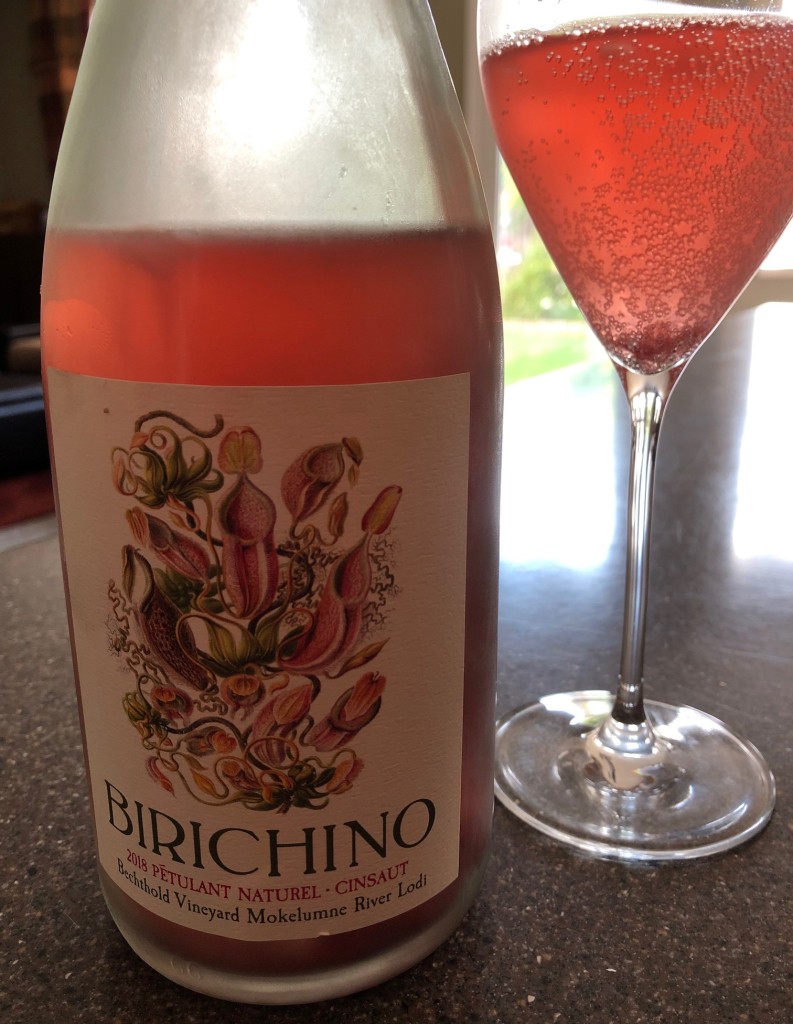This is a seriously fun Pét-nat that was a joy to drink!
For the uninitiated, Pét-nat, or Méthode Ancestrale, is a method of sparkling wine production used all over the world. Unlike traditional-method sparkling wines, like Champagne, which add sugar and yeast to dry, still wine in order trigger a second fermentation and produce bubbles, pét-nat works by bottling wine that is only partially fermented. As the first and only fermentation continues in bottle, the resulting carbon dioxide (CO2) is trapped. After a period of rest that can be as short as a couple of months, the gas is absorbed into the wine as bubbles and the pét-nat is ready to drink. With an increased focus on minimal intervention, natural winemaking this style of sparkling wine is becoming more and more popular. What I love about this style of sparkling wine is that they can be made anywhere from any grape and in any color — red, white, rosé and even orange.
This is one of two wines Birichino makes from Lodi’s Bechthold Vineyard, planted in 1886! The other is their Cinsault rouge. They use the saignéed juice from the Cinsault rouge as the base for this wine.
Color – Cloudy watermelon pink/red
Aromas – Initial funky leesy aromas, but after a bit of air, red fruits, violets and savory dried herbs emerge.
Body – Medium-bodied, frothy and very fresh
Taste – Strawberry, tart raspberry, watermelon, and a hint of kiwi flavors complicated with, very appealing to me, savory saline notes.
Finish – Medium
13% abv| SRP – $25|90pts
This is a seriously fun Pét-nat that was a joy to drink! It paired well with grilled chicken and veggies!
About Birichino
Birichino, (pronounced biri-kino) was founded in Santa Cruz in 2008 by owner/winemakers Alex Krause and John Locke. The pair have deep experience in making and selling wine in California, France, and Italy.
John worked from 1990 to 2007 with the legendary Randall Grahm of Bonny Doon Vineyard, with (the equally legendary) André Ostertag of Domaine Ostertag in Alsace in 1993, and with a host of small producers across Italy and south-western France. Alex started in 1992 with Randall, worked with John in the cellar, and then escaped to the sales side in the later 90’s to eventually serve today as Director of Export Sales for Bonny Doon Vineyard.
They primarily focus on sourcing fruit from old vineyards in the Santa Cruz Mountains appellation (though they’ve also sourced fruit from as far as Lodi and the Sierra Foothills), They have a minimal intervention winemaking aesthetic that’s all about crafting lower-alcohol, food friendly wines with a sense of place.
________________________________________________________________________
Follow me on Twitter, Facebook, Instagram, Vivino and for all things wine. As a wino with latent foodie tendencies, you’ll also find plenty of food and wine pairings, and wine related travel stuff! Become a fan and join ENOFYLZ Wine Blog on Facebook. Cheers!
Copyright Notice: This entire site is Copyrighted 2010-2019. All Rights Reserved. No unauthorized copying of any section of this site is permitted. If you wish to use any part of this site, contact me. For information on Copyright Law, see the official U.S. Copyright Office home page.

I love fruit from Bechthold Vineyard!
I have heard quite a bit about that Bechthold fruit! I love the label! The art work is stunning. This sounds lovely and looks delicious. I am a big Pet-Nat fan. I love bubbles and this is such a wonderful way for smaller and more natural producers to get something out there with bubbles. I also find them richer and as you mentioned, more diverse in varieties and as such, flavor. It is near to impossible to find them locally in Vegas, so we are always looking to pick some up when we visit wine country. At some point, I really need to get to Lodi!
Thanks for commenting Robin. Just so you know, the fruit is from Lodi, the winemakers are based in Santa Cruz. Great point about smaller producers being able to get bubbles on the market!